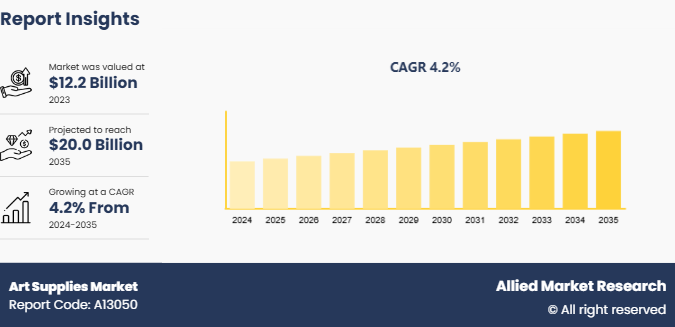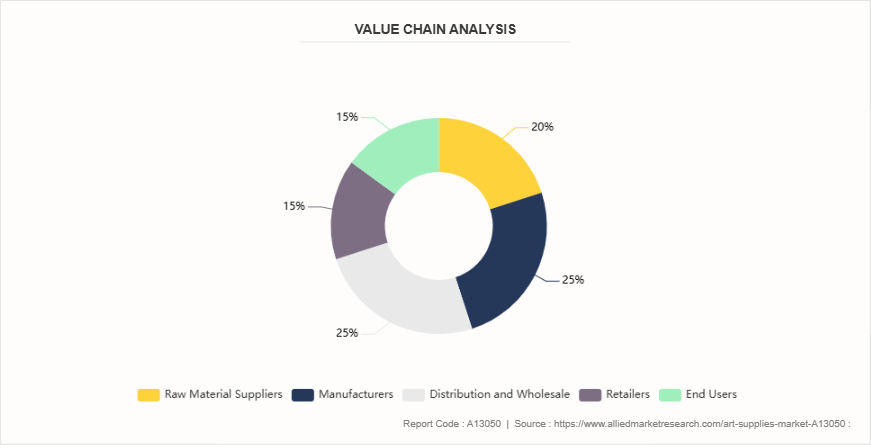Art Supplies Market Research, 2035
Market Introduction and Definition
The global art supplies market size was valued at $12.2 billion in 2023, and is projected to reach $20.0 billion by 2035, growing at a CAGR of 4.2% from 2024 to 2035. Art supplies refer to the materials and tools used by artists, hobbyists, and students for creating various forms of visual art, including drawing, painting, sculpture, and crafting. These supplies include a wide range of products such as paints (acrylic, oil, watercolor) , brushes, pencils, markers, canvases, paper, easels, and other accessories such as palettes, erasers, and sculpting tools. Art supplies are essential for both professional and amateur artists to express their creativity and bring their artistic visions to life. The market for art supplies is driven by factors such as the growing popularity of art as a hobby, increased interest in DIY crafts, and the rising awareness of the benefits of art therapy. In addition, the expansion of e-commerce platforms has made it easier for consumers to access a broader range of art materials.

Key Takeaways
- The art supplies market study covers 20 countries. The research includes a segment analysis of each country in terms of value ($Billion) for the forecast period 2024-2035.
- More than 1, 500 product literatures, industry releases, annual reports, and other such documents of major industry participants along with authentic industry journals, trade associations' releases, and government websites have been reviewed for generating high-value industry insights.
- The study integrated high-quality data, professional opinions and analysis, and critical independent perspectives. The research approach is intended to provide a balanced view of global markets and to assist stakeholders in making educated decisions in order to achieve their most ambitious growth objectives.
Key market dynamics
- The popularity of DIY crafting, particularly through social media platforms such as Pinterest, has increased demand for art supplies. Consumers are taking up hobbies such as painting, scrapbooking, and home decor, prompting higher sales in crafting materials and art supplies.
- As schools and universities incorporate more art-related courses and projects into their curriculum, there is a growing demand for art supplies. Educational institutions, particularly in art schools, are primary consumers of various art materials, driving the art supplies market demand.
- There is a growing recognition of art as an effective form of stress relief and self-expression. Art therapy is being increasingly used in clinical settings, as well as in personal routines, contributing to the growing demand for accessible, therapeutic art supplies.
- The convenience of online shopping has expanded the accessibility of art supplies globally, creating new opportunities for consumers to purchase products from international brands. E-commerce platforms also allow niche art products to reach a broader audience.
- The integration of digital art tools presents an opportunity for traditional art suppliers to branch into the growing digital space. Offering products such as digital tablets, styluses, and creative software bundles will allow companies to tap into the increasing number of digital artists and illustrators.
- Premium and high-quality art supplies can be prohibitively expensive, especially for amateur artists or students. The cost of materials such as professional-grade paints, brushes, and canvases can limit their accessibility, restraining art supplies market growth.

Value Chain Analysis
Each stage in the value chain contributes to the overall value of art supplies industry and influences factors such as pricing, quality, and customer satisfaction. Analyzing each step helps identify areas for improvement and opportunities for innovation in the market.
Raw Material Suppliers
Raw material suppliers provide essential inputs for art supplies, such as pigments, paper, wood, and synthetic fibers. These materials are sourced from various industries, including chemicals, textiles, and forestry. Their role is crucial in ensuring that manufacturers have high-quality, sustainable, and cost-effective materials for producing art supplies.
Manufacturers
Manufacturers process raw materials into finished art products such as paints, brushes, canvases, and drawing tools. They focus on product design, quality control, and packaging. Their ability to innovate and meet consumer demands for sustainable and specialized products drives the market. Large-scale manufacturers often work with third-party suppliers for efficient production.
Distribution and Wholesale
Distributors and wholesalers act as intermediaries, purchasing art supplies in bulk from manufacturers and selling them to retailers or other customers. They ensure that products are readily available across diverse regions. These channels often handle logistics, warehousing, and bulk sales, making them key to reaching widespread markets efficiently.
Retailers
Retailers, both online and offline, sell art supplies directly to consumers. They play a critical role in providing accessible shopping experiences and tailored customer service. Large chains, specialized art supply stores, and e-commerce platforms offer a wide variety of products, making art supplies available to artists of all skill levels, including niche products.
End Users
End users are the artists, students, hobbyists, and professionals who purchase and use art supplies. Their preferences, buying behaviors, and feedback influence market trends. End users are increasingly seeking sustainable, affordable, and high-quality products, with online communities and social media platforms shaping consumer demand and driving innovation.
Market Segmentation
The art supplies market is segmented into product type, end user, distribution channel, and region. By product type, the market is divided into painting supplies, drawing supplies, craft supplies, and others. By end user, the market is classified into household, professional artists, institutions, commercial, and others. As per distribution channel, the market is bifurcated into online, and offline. By region, the market is analyzed across North America, Europe, Asia-Pacific, LAMEA.
Regional Market Outlook
North America region held the major art supplies market share in 2023. The region's established art culture, supported by a long-standing tradition of both professional and amateur artists, plays a significant role. The U.S. has a large consumer base, including a thriving community of hobbyists, students, and professionals, all of whom contribute to the demand for art supplies. In addition, North America boasts a well-developed retail infrastructure, with numerous specialty stores, large retailers, and e-commerce platforms that provide easy access to a wide range of art materials.
Industry Trends
- There is a growing trend toward sustainability in the art supplies market, with more artists and consumers seeking eco-friendly options. Manufacturers are increasingly offering products made from recycled materials, organic pigments, and biodegradable packaging. This trend reflects broader societal concerns about environmental impact and is gaining momentum as consumers become more conscientious about the ecological footprint of their purchases.
- With the rise of digital art and illustration, many traditional arts supply companies are integrating their offerings with digital tools. This includes specialized digital brushes, styluses, and software packages designed for artists. The integration of traditional and digital mediums allows artists to seamlessly transition between physical and virtual platforms.
- Customization has become a notable trend, with consumers looking for personalized products. This includes custom brushes, specialty pencils, or even personalized packaging. As consumers seek more individuality in their creative process, art supply companies are offering personalized options to cater to these preferences.
Competitive Landscape
The major players operating in the art supplies market include Crayola LLC, Faber-Castell, Winsor & Newton, Pentel Co., Ltd., Prismacolor, Liquitex, Da Vinci Brushes, Sakura Color Products Corporation, Koh-I-Noor Hardtmuth, and Canson Inc.
Key Benefits For Stakeholders
- This report provides a quantitative analysis of the market segments, current trends, estimations, and dynamics of the art supplies market analysis from 2024 to 2035 to identify the prevailing art supplies market opportunities.
- The market research is offered along with information related to key drivers, restraints, and opportunities.
- Porter's five forces analysis highlights the potency of buyers and suppliers to enable stakeholders make profit-oriented business decisions and strengthen their supplier-buyer network.
- In-depth analysis of the art supplies market segmentation assists to determine the prevailing market opportunities.
- Major countries in each region are mapped according to their revenue contribution to the global market.
- Market player positioning facilitates benchmarking and provides a clear understanding of the present position of the market players.
- The report includes the analysis of the regional as well as global art supplies market trends, key players, market segments, application areas, and market growth strategies.
Art Supplies Market Report Highlights
| Aspects | Details |
| Market Size By 2035 | USD 20.0 Billion |
| Growth Rate | CAGR of 4.2% |
| Forecast period | 2024 - 2035 |
| Report Pages | 305 |
| By Product Type |
|
| By End User |
|
| By Distribution Channel |
|
| By Region |
|
| Key Market Players | Pentel Co., Ltd., Faber-Castell, Sakura Color Products Corporation, Liquitex, Da Vinci Brushes, Crayola LLC, Winsor & Newton, Canson Inc, Prismacolor, Koh-I-Noor Hardtmuth |
The art supplies market was valued at $12.2 billion in 2023 and is estimated to reach $20.05 billion by 2035, exhibiting a CAGR of 4.2% from 2024 to 2035.
The art supplies market is segmented into product type, end user, distribution channel, and region. By product type, the market is divided into painting supplies, drawing supplies, craft supplies, and others. By end user, the market is classified into household, professional artists, institutions, commercial, and others. As per distribution channel, the market is bifurcated into online, and offline. By region, the market is analyzed across North America, Europe, Asia-Pacific, LAMEA.
North America is the largest regional market for art supplies
The major players operating in the art supplies market include Crayola LLC, Faber-Castell, Winsor & Newton, Pentel Co., Ltd., Prismacolor, Liquitex, Da Vinci Brushes, Sakura Color Products Corporation, Koh-I-Noor Hardtmuth, and Canson Inc.
The global art supplies market report is available on request on the website of Allied Market Research.
Loading Table Of Content...



